Animal suffering is a global problem that requires action on a global level. How can we think about effectiveness across geographical and cultural contexts? How can North American and European advocates support advocacy in other parts of the world, such as India and China, in responsible and impactful ways? In this talk, Marianne van der Werf of Animal Charity Evaluators explores the pros and cons of different approaches to international advocacy.
We’ve lightly edited a transcript of Marianne’s talk for clarity. You can also watch it on YouTube and read it on effectivealtruism.org.
The Talk
Habiba Islam (Moderator]: Hello, and welcome to “Animal advocacy in a global context,” with Marianne van der Werf. I'm Habiba Islam, and I'll be the emcee for this session. We'll be starting with a 15-minute talk by Marianne. Then we'll move on to a live Q&A session, where she'll respond to [audience members’] questions. [...]
Now I'd like to introduce our speaker for this session. Marianne van der Werf is the Program Officer for the Effective Animal Advocacy Fund at Animal Charity Evaluators. She is committed to reducing the worst forms of suffering for all sentient beings. She has been involved in effective altruism and animal advocacy since 2015, and she worked with a few different EA organizations before joining Animal Charity Evaluators in 2019.
Marianne is excited to contribute to the animal advocacy movement by identifying promising funding opportunities. Here's Marianne.
Marianne: Hi, everybody. Thank you for coming. My name is Marianne van der Werf. I'm with Animal Charity Evaluators. I've been involved in the effective altruism community and the animal advocacy community over the past five years. Thank you for coming to today's talk about international animal advocacy.

Animal advocacy is a global issue. Animals are suffering all over the world; therefore, [addressing this problem] requires global solutions and a global scope. Most organizations and most funding in the movement, however, are located in North America and in Western Europe. This talk will [focus on] how we can work effectively to contribute to a more equitable distribution of these resources, and what ACE sees as the best approaches to this topic.

ACE sees this as a global issue, but we mainly have a US lens. We're registered in the US and most of our employees are from the US. This also means that most of our connections are in the US, and [our understanding of the context around this issue is based on what’s happening] in the US. We have [a few] employees from different countries, but it's usually hard to have the same types of disagreements and discussions that we can have about the US context.
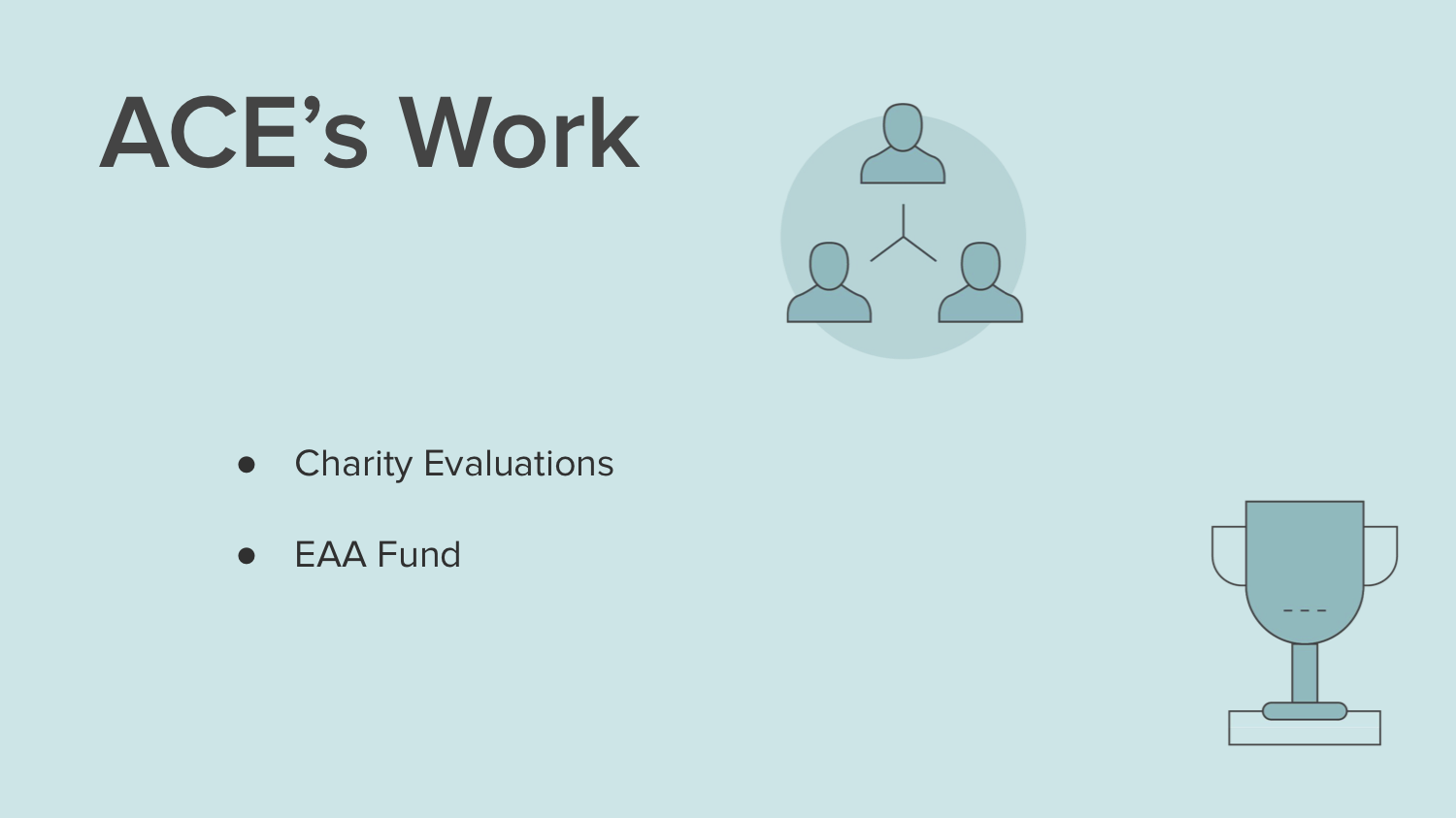
At ACE, we do [a variety of] things, but the areas of our work that are most relevant to today's topic are our charity evaluations (this is why we are called Animal Charity Evaluators). For this project, we start with a long list of charities, and we narrow it down a smaller list to evaluate in depth. [In 2020], we aim to evaluate 15 charities.
We also have the EAA [Effective Animal Advocacy] Fund, which I run. All [animal advocacy] charities can apply for funding. Usually these are smaller organizations that are less well-funded than the charities that we evaluate. We read and review [their applications] and discuss [which organizations] will receive a grant.

Questions that come up a lot in our work are:
* How can we evaluate charities in countries that are outside [the US, given our US-based experience]? This is relevant to our evaluations and our grant decisions, and also [may interest] those who work at a research organization that recommends animal charities, [or who] want to support charities outside of their own country with personal donations.
* How do we evaluate organizations’ [approach to] international expansion? For example, if we are evaluating a charity based in the US, but with subsidiaries in the UK, Germany, India, or Brazil, how do we evaluate [their] practices? How can we tell whether they're doing a good job? These are questions that are also relevant to people who may want to start their own charity in a different country than the one that they're from, or who want to donate to an organization that is expanding internationally.

Let’s briefly discuss how we evaluate countries that are outside of our expertise. We do a lot of research. We have in-depth country reports for India, China, and Brazil. We also have a blog post where we invited people to talk about animal advocacy in their countries. And we rely on the research that others have done, of course. Also, we ask charities and animal advocates in our network how they perceive a specific approach or charity in their region.
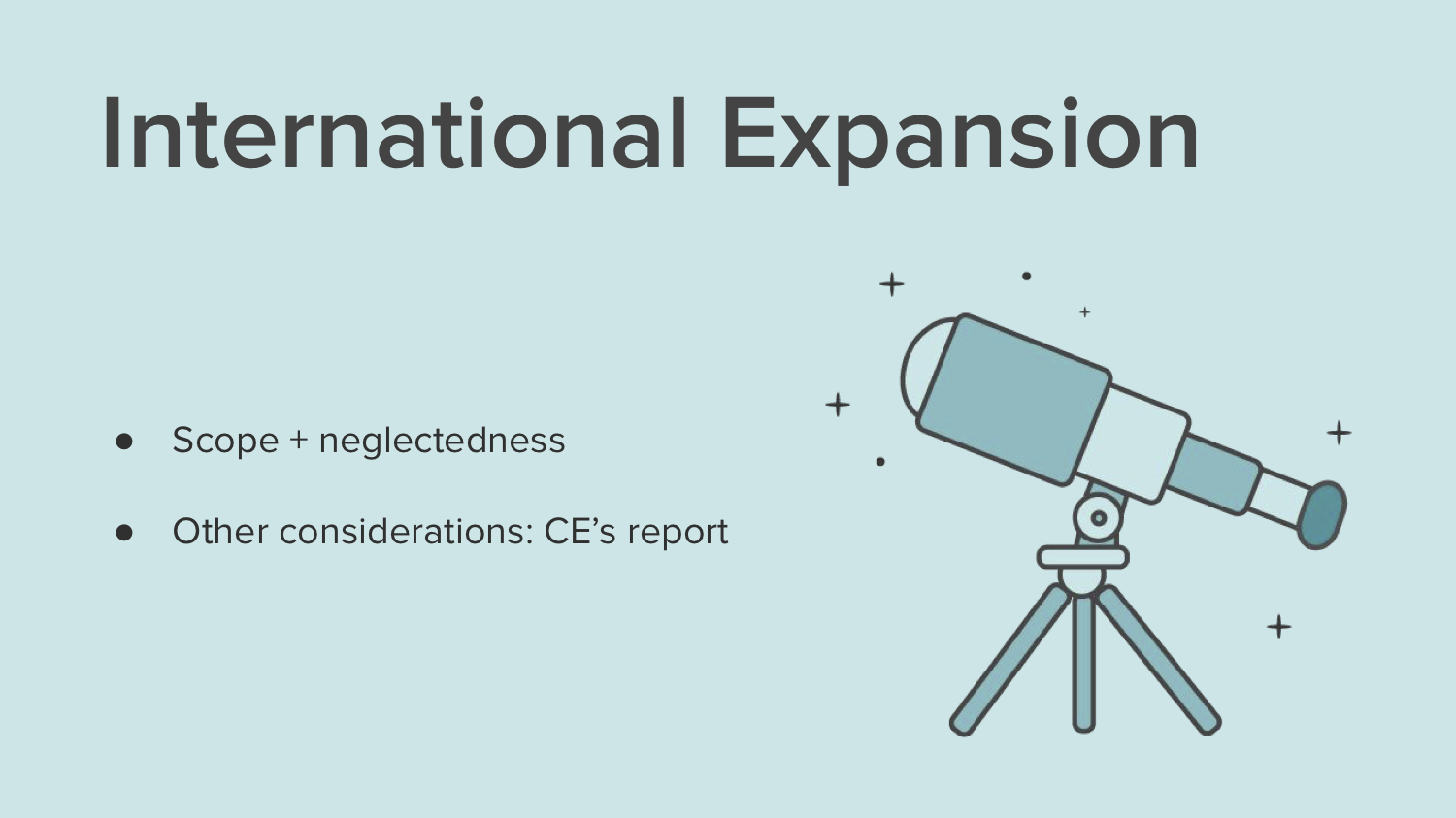
Let's [turn to] how we evaluate charities that expand internationally. First, let's discuss why charities may want to do this. [As I mentioned,] there are animals suffering all over the world. How we prioritize where we work is very important. Because this is a talk for EAs [the effective altruism community], I'm going to [address] scope and neglectedness.
For those who are unfamiliar with these terms, scope basically means the size of the problem. In different countries, more or fewer animals are killed for food, so the scope of the problem differs by country. Scope also matters because there could be fewer or more regulations protecting these animals from suffering [in certain countries], which could mean that the scope of their suffering is greater or lesser than in other places.
Neglectedness means [the extent to which] resources are put toward [solving] a problem. If there are not many resources [funneled toward] the problem, the problem is neglected. This also differs by country. Even though animal advocacy is very much neglected everywhere in the world, in North America and in Western Europe, we do have NGOs and organizations with tens, and sometimes hundreds, of people working full-time on these issues, which is great. But [animal welfare] organizations in other regions are not large. There is the potential for low-hanging fruit there.

So, there are very good reasons why organizations may want to expand internationally. But there are also risks involved. If an organization with a large budget were to expand to a country where the animal advocacy movement doesn't have the same amount of resources, sharing these resources with this new region can be [beneficial]. But it can also be risky, because [the organization] can have a big influence on how the movement in that country develops and is perceived. There's a real risk of doing harm.
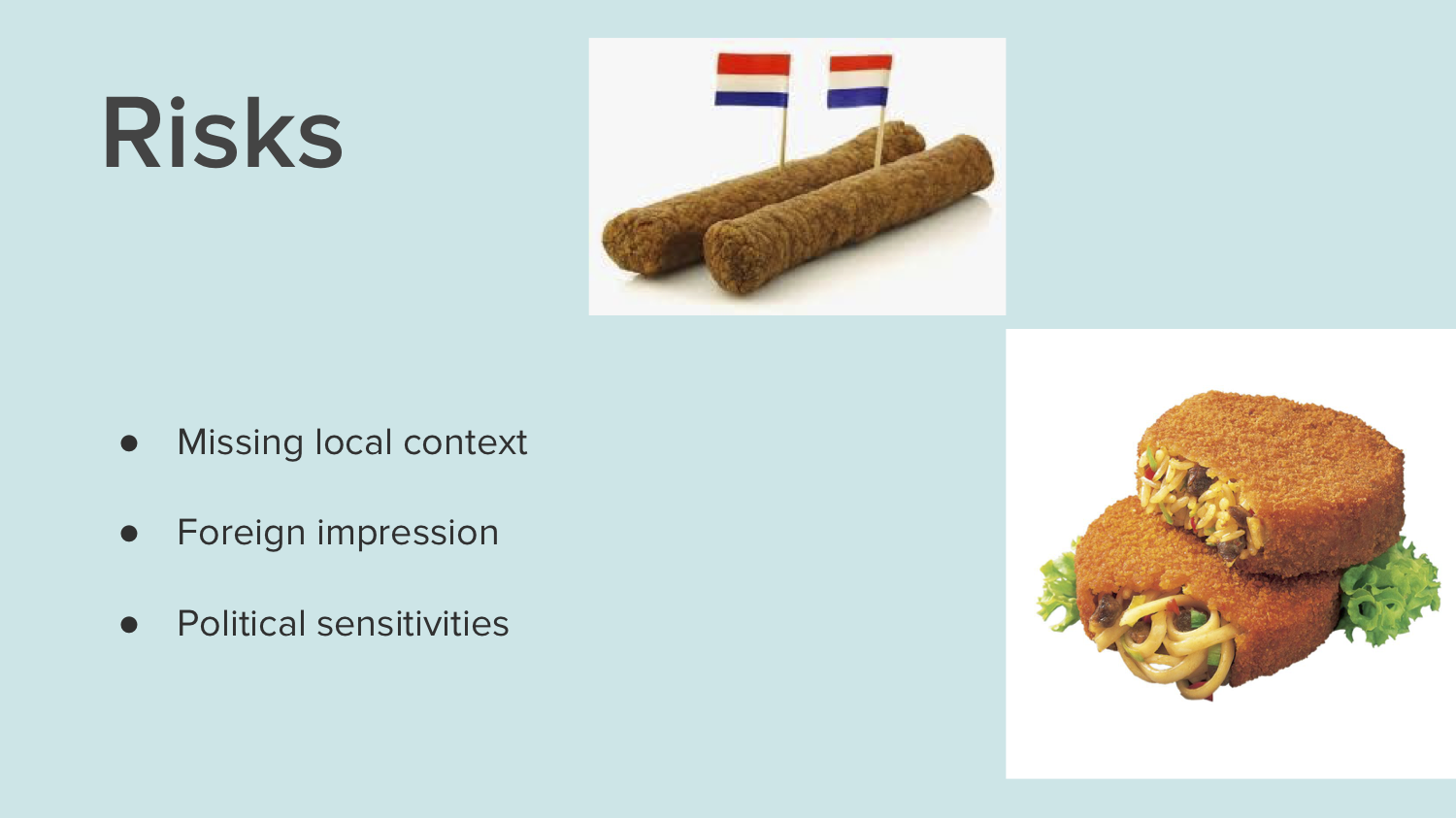
[For example,] someone who is Dutch, like me, may have a successful vegan snacks company in the Netherlands. I may sell snacks that the Dutch people in the audience wo;; recognize: the frikandellen [vegan hot dog] (which my friends and I were very suspicious of when we were kids because we heard that there were horses in it) and the bamischijf, which is the Dutch interpretation of Indonesian cuisine.
These snacks [could sell well in] the Netherlands, but in the United States, people may not have the same appreciation for them. And if the company [weren’t well-funded], it may not have much impact. But if I had a lot of money and resources, I could push a very aggressive ad campaign. This might have a negative impact, as people in the US may perceive veganism as “that annoying woman who tries to push frikandellen in the United States.” How animals are treated and the kinds of foods we eat are very much tied to culture. So naturally, they are a sensitive topic.
This is especially true in regions that have been colonized by Western countries — for example, in India, where people will have, understandably, a large distrust of Western groups aiming to change the culture.
Varda Mehrotra, who is Executive Director of FIAPO (which is an ACE standout charity in India) gives the example of how, in the state of Tamil Nadu in South India, there is a practice called jallikattu, which is a form of bullfighting. The Supreme Court ruled that this practice should be banned, but obviously, that received opposition from people who wanted to continue the practice. And because an Indian branch of a US organization was involved, the people who wanted to continue the bullfighting were able to frame the animal advocacy campaign as Western organizations looking to destroy the Tamil culture. This example is from India, but is relevant to countries all over the world.
Another example is from China. The political system there requires a lot of sensitivity; doing the wrong thing can not only harm the movement there, but also endanger people who are working on veganism in their country. It's easy to underestimate the negative impact when we don't fully understand the local context.
There are some ways to mitigate these risks, which we can do by following what ACE considers to be best practices:

First, support the local movement. If you are coming in as a country with more resources in the animal advocacy movement, aim to support the local movement of the region you are moving into, and not try to lead it. We believe the most effective way to help animals is not necessarily the one that promotes your own organization the most.
We also believe that supporting the local movement is more sustainable in the long term, and certainly less risky. It involves listening and learning from local advocates, and understanding why they chose certain campaigns and how your resources can support them. These resources might include funding, strategic advising, and expertise in specific disciplines.
One initiative that does this very well is the Open Wing Alliance, which is a part of The Humane League, another ACE top charity. The Open Wing Alliance is a coalition of small groups that work on cage-free campaigns all over the world. They also provide grants and trainings. This is a great example of how a US-based organization can support local movements around the world.
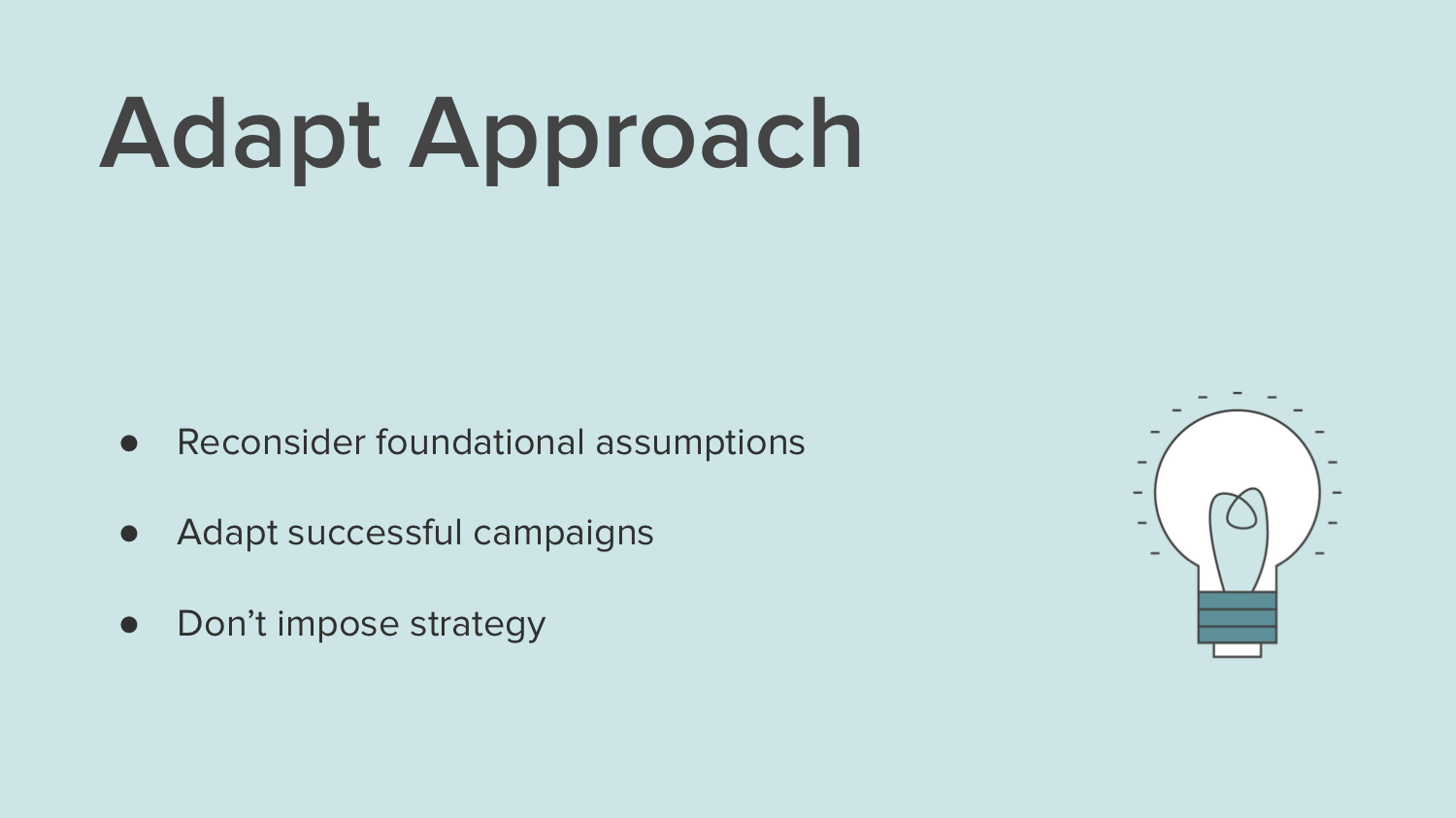
A second best practice is to adapt your approach. This includes reconsidering the assumptions underlying the campaigns that you're [conducting] in your main region to see if they also hold up in the region [you’re entering]. One such assumption [is that the same] groups of animals are being farmed and consumed. But cuisines differ all over the world. An example of this is the number of goats killed. In the United States, there are 10 times fewer goats killed than cows killed. Therefore, a campaign focusing on goats in the United States may not be perceived as effective. But in another country, there may be many more goats killed; globally, about twice as many goats are killed as cows.
Adapting your approach also means updating your goals. Don't just copy a successful campaign that worked in your main region. Adapt it to the context of a new region. Anima International, for example (also an ACE top charity), works very collaboratively on campaigns with local groups in different countries. They [select] campaign names and branding with local advocates, and they also help local advocates by sharing the types of strategies that work in different countries. They don't impose these strategies, but they will explain them so that the local advocates can adapt them to their own context.
One example that Anima mentions is how the English language is perceived. For campaigns in some regions, it may be good to have an English-language [ad] banner, because English may be associated with being modern and cosmopolitan. But in other regions, it may be perceived as something foreign that is being imposed on a country.
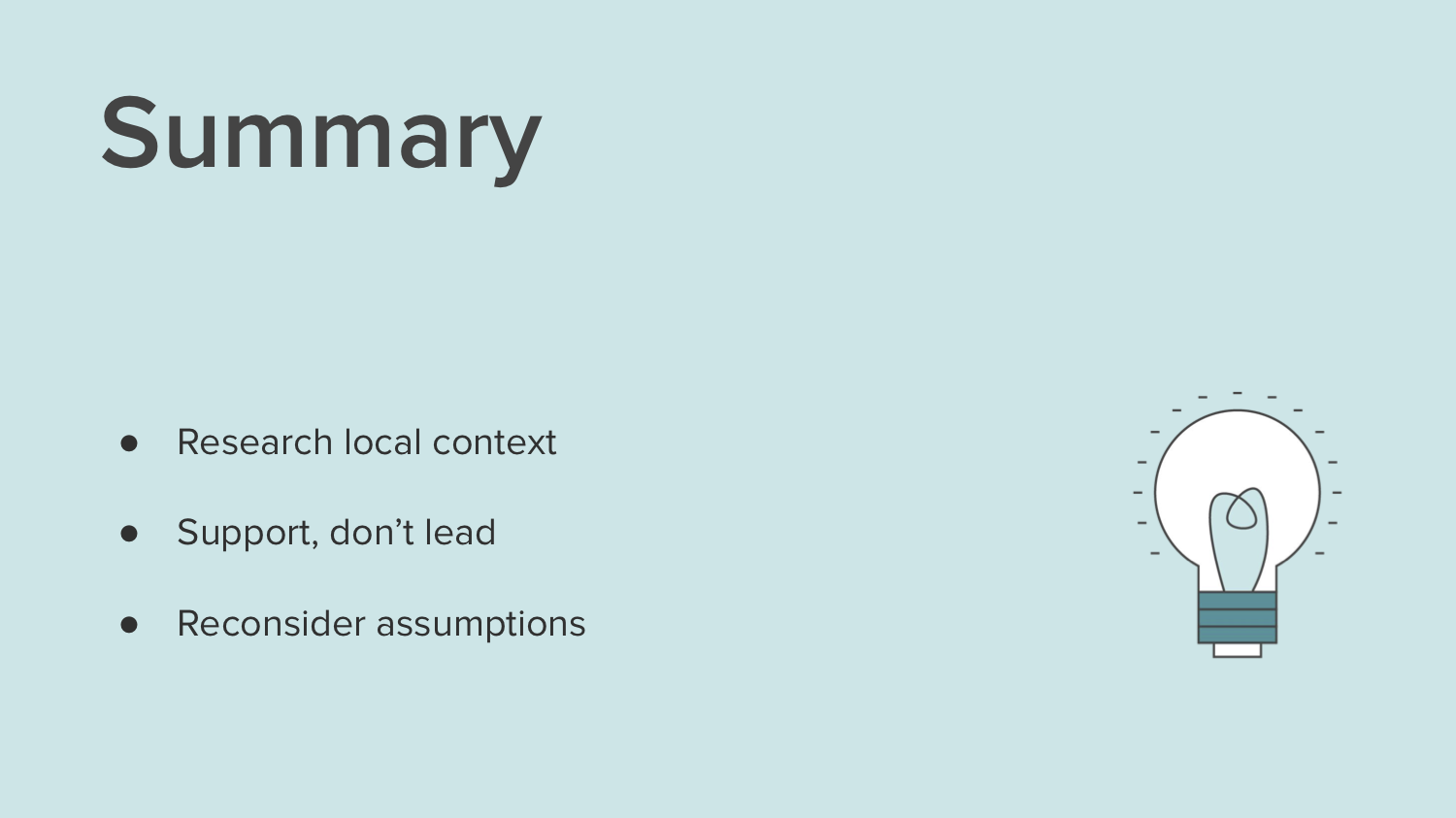
In summary, if you want to support organizations in a different country, it can be helpful to research the local context. If you want to expand your organization into a different country, I would recommend that you support the local movement, [but not in a leadership capacity], and that you reconsider any assumptions that have worked [elsewhere].

Some other relevant resources on this topic are Animal Charity Evaluators' country reports on India, China, and Brazil. We also have a roundtable blog post on international expansion. And I would recommend Charity Entrepreneurship's country prioritization report, [which shares] how they prioritize countries for their projects.
[...]
Thank you for coming. And let me know if you have any questions, or if you want to discuss these topics further. Here’s my email address: marianne@animalcharityevaluators.org.
Habiba: Thank you for that talk, Marianne. I see we've already had a number of questions submitted on the Slido app. We'll try to get through as many as we can.
First of all, I want to give you the chance to explain the difference between the EAA Fund and the other charities that ACE reviews.
Marianne: ACE [conducts] in-depth reviews [to arrive at] our charity recommendations. This involves a lot of communication with the charities and the leadership. It takes the research team a few months. The EAA Fund is for smaller charities that are less established and may not have as much of a track record. It also involves less research.
Our aim with our charity evaluations, which we [conduct] once a year, is to identify the most promising charities — usually for donors. Therefore, they must have a lot of room for more funding. That is why those are more established charities; they have a larger budget, so can absorb more funding.
The EAA Fund [was designed] to complement those, because — although there are [significant] variations among them — they are [often] large and stable, as well as similar [in terms of] the work they do. The EAA Fund [allows ACE] to support other kinds of work, because we don't believe that the charities we recommend are necessarily the only ones that people should support. The EAA Fund gives other charities an opportunity to develop, and perhaps become some of our top charities in the future.
Habiba: We've had a lot of questions around research methodology and how you approach evaluating charities. And so, feel free to draw a distinction between how charities are evaluated for the EAA Fund, [versus] ACE's reviews. One question is: How do you rate sentience for each living being in your research? And is this used as a weighted factor, for specific policy changes?
Marianne: That's a good question. It’s also a very difficult topic, and not one that I [see as] a main consideration in our work.
I think what [sentience] means is that a different species may have a different capacity for having experiences. Some species of animals may be able to suffer more or less [than others]. Maybe they have more pain receptors, or don't have complicated feelings, such as jealousy, that a more complex species may have.
That is a consideration [when determining] which groups of animals to focus on. And I think it is so difficult to make those distinctions. Personally, I think that a lot of speciesism can be involved when we [assume], for example, that insects may have less capacity for suffering than humans, pigs, or other large animals with which we may [more easily] identify. That's a real risk.
When we're making decisions about which charities or approaches to focus on, we find that there are not many projects [focused] on invertebrates. I don't think it is a question of [having] equal projects for every species; usually, the considerations are more [along the lines of] “What will the impact be in the future?” If the charity is focused on invertebrates, then the question would be more about moral-circle expansion, and [increasing] considerations for invertebrates in the future, so that we can do more research and fully understand these individuals.
Habiba: Yes, that’s a complicated question. Here’s another question about your review process: How do you make tradeoffs between capacity building and direct work in countries where the animal advocacy community is small?
Marianne: That's another question that we've been thinking about: What do we see as the best approach to growing the animal advocacy movement in a specific region? I think for the EAA Fund, we [tend] to focus more on capacity building.
For example, we would find it compelling if an organization wants [to run a] campaign on something that is not directly in ACE's cause area, such as circus animals, fur, or something else that would not be prioritized [in our evaluations of top charities], but would enable the organization to build connections with others, raise funds, and build more capacity and skills. [From there, they] could move on to other work that would be more in line with ACE's priorities, such as focusing on chickens or fish.
In those cases, we would have a preference for focusing on the [capacity-building work that might have a bigger long-term impact[. For example, we like to fund things like hiring a fundraiser, or doing something that assists a project over the long term.
Habiba: What are the greatest challenges in channeling funds from Northern America and Europe to [other regions] — especially to neglected Asian countries?
Marianne: That's a good question. I think there are different challenges. First, it is sometimes hard for organizations to accept foreign funding. They may need to have certain permits [in order for it to] be allowed.
There are also considerations that make it difficult for ACE to understand the context of those countries and [determine what] the most effective approaches there are. And there's a language barrier, because ACE's work is all in English and our contacts are mostly English-speaking people.
We did translate some of our materials into Spanish so that they would be more accessible for people who primarily speak Spanish to apply for the EAA Fund. But I would say those are the main challenges.
Habiba: There are also a lot of questions around trying to rank different types of interventions in [the EAA Fund]. Someone has asked, “How would you compare — or should we compare — charities that reduce animal farming suffering to charities that promote veganism and plant-based food?”
Marianne: That's a good question. I think it really depends on the context. I don't have a specific number in mind; for example, I don’t necessarily want 60% to be focused on farmed animals. But I consider what other organizations are funding and interested in. I know that for plant-based eating, there are [funders] focused on health and the environment, [and therefore] able to provide funding related to [plant-based food].
Another consideration is that people are more receptive to [plant-based foods as] a way to change their diet. I think that makes [it more of a] health issue, because diet is such a personal thing. I feel that [the issue of] farmed animals is more political, more about improving the world. Diet and personal consumption may not necessarily be that way. But that may depend on your views on how the economics work, and what the impact of buying a [veggie] burger instead of a cow burger is.
One consideration that I also find compelling is that people who eat plant-based products [to create] healthier environments are more likely to be receptive to the arguments of anti-speciesism and animal welfare. I think that is important.
[In terms of making decisions] for the EAA Fund, it really depends on the context. We have tended not to fund projects that [present] plant-based eating as a cure for all diseases, or something like that. But I think we would find an intervention promising if it were about changing the government's recommendations for healthy eating, for example. That is more systemic, and it doesn't make strong claims about diet and how [plant-based eating] relates to health issues.
Habiba: The worry is the overblown claims being unreliable.
It seems that there are a lot of different, hard-to-make decisions between [various] strategies. Am I right in assuming that one of the reasons that ACE set up this particular fund, is because it's quite hard to judge these different interventions — and because we don't have enough evidence to conclusively say that some things are better than others, and therefore, ACE wants to take a pluralist approach to funding?
Marianne: Yes, that's right. We see the EAA Fund as complementing our recommended charities. We have recommended charities that we feel confident will use donations very well. But we don't think that all funding in the movement should go to that small number of charities and approaches.
Habiba: One last question on the specific approach. What's the state of wild animal welfare advocacy outside the US and Europe? Do you have a view on this?
Marianne: I know that some organizations are trying to do more global work, but I don't have a good feel for how [it’s going] outside of the US and Europe. I'm generally excited about growing the field of wild animal welfare.
Habiba: Circling back a bit, what do you see as the most underrated or overrated strategies in the movement as a whole?
Marianne: One approach that is underrated is making very bold claims [and engaging in] animal advocacy protests. I would really like to see more people who have strong “do not use any animals” messaging. I think that incremental welfare changes are really good, and the organizations that are doing work in that area are really excellent.
But for the EAA Fund I would really like to [see] more applicants that are strategic about [messaging] and have a strong claim. Examples might be getting rights for some nonhuman animals or closing down specific slaughterhouses. Personally, I think those would be promising. Or, [an organization could focus on] behind-the-scenes [tactics that entail] understanding local politics and making change for animals there.
Habiba: Could you provide some examples of projects in other countries that ACE found particularly interesting and funded in previous rounds?
Marianne: Yes, there are a lot that I'm very excited about. For instance, we [supported] a great project from Vegans of Shanghai, which worked on plant-based eating around Shanghai. Essere Animali does great work in Italy, and they’re improving their internal processes. That’s something that, from the outside, you may not see, but I think it is key to making the movement more sustainable.
Habiba: There's a full list of the previous fundees on your website [see first- and second-round 2019 grantees] if you want more details about who has received funding in the past.
I'll say hello to your bird [chirping in the background]. What's the bird’s name?
Marianne: This is Emily.
Habiba: Hi, Emily. We'll carry on, and maybe she can pitch in with some answers.
Switching to careers [in animal advocacy], someone has pointed out that a lot of the approaches that you find promising and want to fund are in branding, international marketing, and things like that.
Those kinds of careers are underrepresented by 80,000 Hours. I should point out that I work for 80,000 hours, so don't feel obliged to hold back any criticism.
The question is: Do you [endorse following] those careers? If people want to work in this area, should they be going into communications, branding, or international marketing types of roles?
Marianne: I don't think I have a good feel for that. I know that the organization Animal Advocacy Careers is looking into promising career paths for people in animal advocacy. They are looking into the bottlenecks.
But [I’m not sure which] types of careers I would recommend that people go into, or in which I feel confident that they would get a job in animal advocacy. I think it would depend more on whether people are good fits and excited about these career paths, and whether the organizations have opportunities or interests in growing into these areas.
Habiba: Yes, that's a great plug for Animal Advocacy Careers, which is a new organization set up to look at careers specifically in animal welfare.
I can chip in and say that, as someone who works for 80,000 Hours, if you're looking for career advice on reducing animal suffering, then 80,000 Hours [currently] isn't the best resource for you. Animal Advocacy Careers can give you better-researched and more advice in that area.
Marianne: I'm also always happy to talk with people about their specific career paths.
Habiba: Here’s one last question on future directions of research: In ACE's plans for this year, there's a desire to look more into a long-termist [perspective], and [explore] how that connects to some of the research with the wider EA movement’s thinking. Someone has asked whether long-termists' considerations have gone into ACE’s recommendations or evaluations to date.
Marianne: I'm thinking about [this in light of] the theory of change [surrounding] our current recommendations. I think that perhaps the problem is that we are not sure about which different interventions would contribute to long-termist considerations.
Personally, I think of long-termist considerations [in terms] of moral-circle expansion and [the world’s geopolitical situation becoming] more stable. I think if people are less biased and care about individuals that are different from them, then that [creates] stability. Speciesism is one of my main concerns.
I think that this is especially [important] in situations where technology could have a much bigger impact on our lives. If the values that are in that technology are [exclusively designed to benefit] our species, that would be very concerning, and could cause a lot of suffering.
I don't know which interventions would contribute to that. I think all interventions that work to end factory farming could expand the moral circle for nonhuman animals. Some that are maybe more on the edge of that include research into invertebrate sentience or animal suffering in general. Others are about spreading anti-speciesist views, and might include getting legal rights for certain species of animals and seeing some species as full persons.
One thing that we wouldn't support is projects or initiatives promoting high-welfare meat. Personally, I [believe] that the negative messaging and reinforcement of speciesism could be harmful over the long term.
Habiba: [...] Unfortunately, that concludes the Q&A part of this session. Thanks to everyone who sent in questions. I’m sorry if we didn't get to yours, including a few about Emily!
